第7章 二叉树大全
7.1 二叉树的定义
任何一个节点的子节点数量不超过 2,那就是二叉树;二叉树的子节点分为左节点和右节点,不能颠倒位置
7.2 二叉树的性质(特性)
性质1:在二叉树的第i层上至多有2^(i-1)个结点(i>0)
性质2:深度为k的二叉树至多有2^k - 1个结点(k>0)
性质3:对于任意一棵二叉树,如果其叶结点数为N0,而度数为2的结点总数为N2,则N0=N2+1;
性质4:具有n个结点的完全二叉树的深度必为 log2(n+1)
性质5:对完全二叉树,若从上至下、从左至右编号,则编号为i 的结点,其左孩子编号必为2i,其右孩子编号必为2i+1;其双亲的编号必为i/2(i=1 时为根,除外)
7.3 满二叉树与完全二叉树
满二叉树: 所有叶子结点都集中在二叉树的最下面一层上,而且结点总数为:2^n-1 (n为层数 / 高度)
完全二叉树: 所有的叶子节点都在最后一层或者倒数第二层,且最后一层叶子节点在左边连续,倒数第二层在右边连续(满二叉树也是属于完全二叉树)(从上往下,从左往右能挨着数满)

7.4 链式存储的二叉树
创建二叉树:首先需要一个树的类,还需要另一个类用来存放节点,设置节点;将节点放入树中,就形成了二叉树;(节点中需要权值,左子树,右子树,并且都能对他们的值进行设置)。
树的遍历:
- 先序遍历:根节点,左节点,右节点(如果节点有子树,先从左往右遍历子树,再遍历兄弟节点)
先序遍历结果为:A B D H I E J C F K G
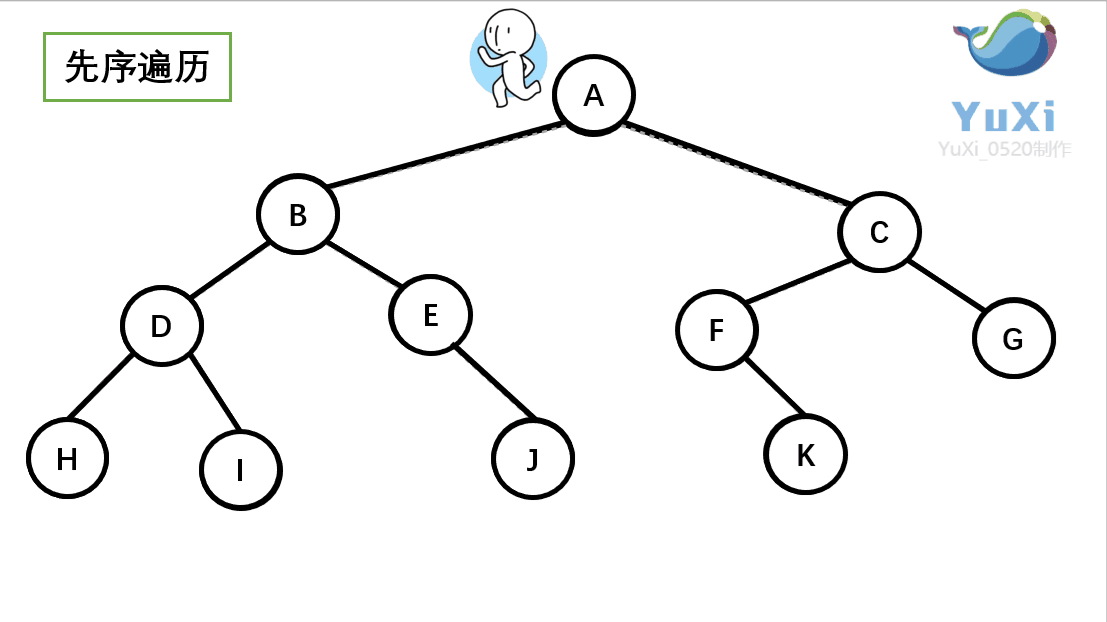
- 中序遍历:左节点,根节点,右节点(中序遍历可以看成,二叉树每个节点,垂直方向投影下来(可以理解为每个节点从最左边开始垂直掉到地上),然后从左往右数)
中遍历结果为:H D I B E J A F K C G

- 后序遍历:左节点,右节点,根节点
后序遍历结果:H I D J E B K F G C A
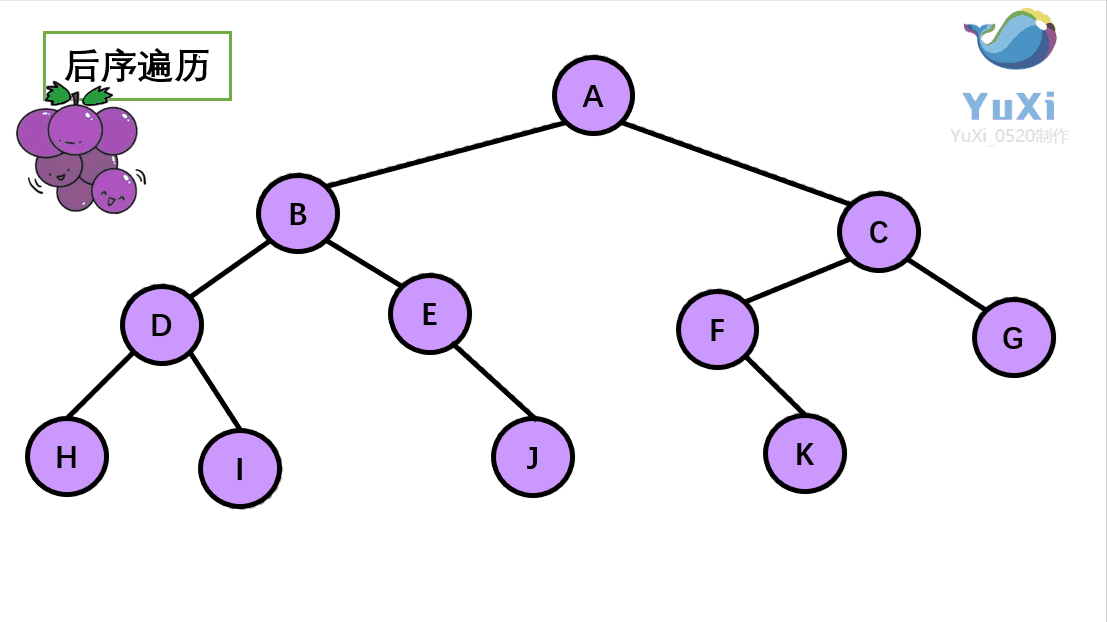
- 层次遍历:从上往下,从左往右
层次遍历结果:A B C D E F G H I J K 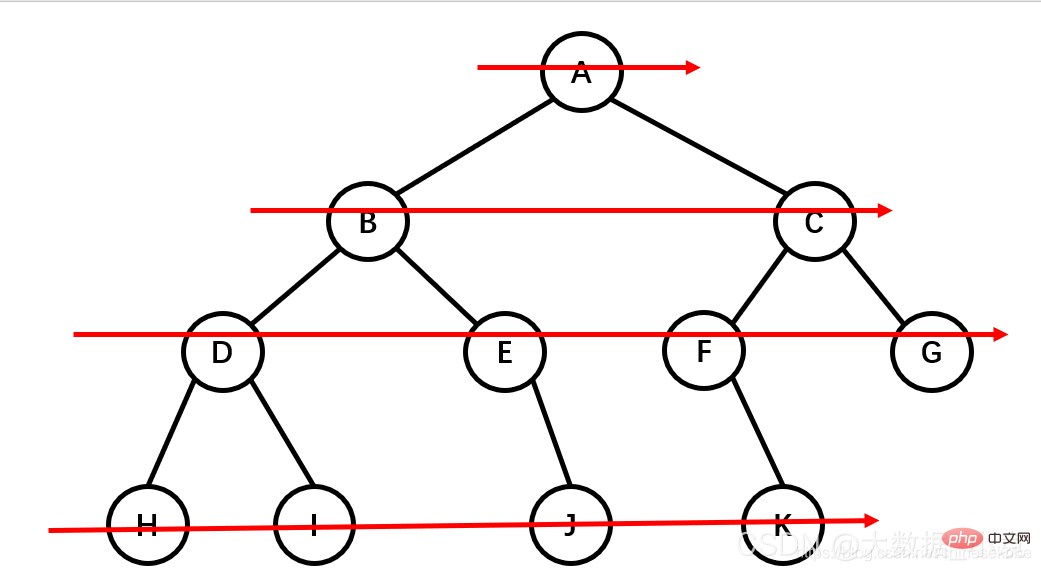
查找节点:先对树进行一次遍历,然后找出要找的那个数;因为有三种排序方法,所以查找节点也分为先序查找,中序查找,后序查找;
删除节点:由于链式存储,不能找到要删的数直接删除,需要找到他的父节点,然后将指向该数设置为null;所以需要一个变量来指向父节点,找到数后,再断开连接。
代码实现:
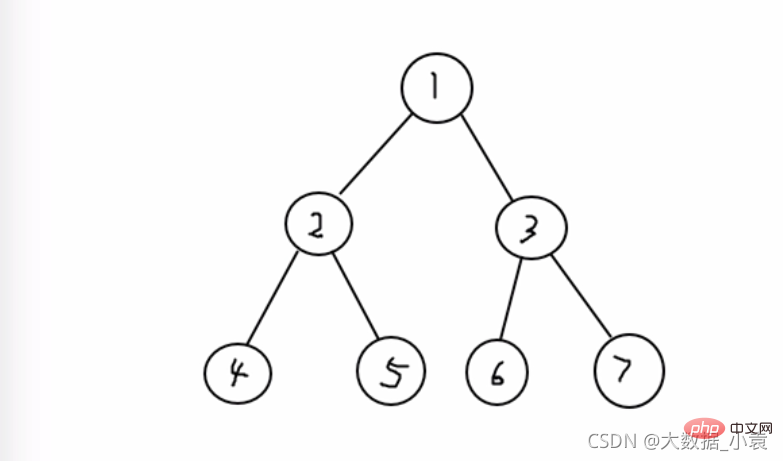
| 1 2 3 4 5 6 7 8 9 10 11 12 13 14 15 16 17 18 19 20 21 22 23 24 25 26 27 28 29 30 31 32 33 34 35 36 37 38 39 40 41 42 43 44 45 46 47 48 | public class BinaryTree {
TreeNode root;
//设置根节点
public void setRoot(TreeNode root) {
this.root = root;
}
//获取根节点
public TreeNode getRoot() {
return root;
}
//先序遍历
public void frontShow() {
if (root != null) {
root.frontShow();
}
}
//中序遍历
public void middleShow() {
if (root != null) {
root.middleShow();
}
}
//后序遍历
public void afterShow() {
if (root != null) {
root.afterShow();
}
}
//先序查找
public TreeNode frontSearch(int i) {
return root.frontSearch(i);
}
//删除一个子树
public void delete(int i) {
if (root.value == i) {
root = null;
} else {
root.delete(i);
}
}}
|
| 1 2 3 4 5 6 7 8 9 10 11 12 13 14 15 16 17 18 19 20 21 22 23 24 25 26 27 28 29 30 31 32 33 34 35 36 37 38 39 40 41 42 43 44 45 46 47 48 49 50 51 52 53 54 55 56 57 58 59 60 61 62 63 64 65 66 67 68 69 70 71 72 73 74 75 76 77 78 79 80 81 82 83 84 85 86 87 88 89 90 91 92 93 94 95 96 97 98 99 100 101 102 103 104 105 106 107 108 109 110 111 112 113 114 | public class TreeNode {
//节点的权
int value;
//左儿子
TreeNode leftNode;
//右儿子
TreeNode rightNode;
public TreeNode(int value) {
this.value = value;
}
//设置左儿子
public void setLeftNode(TreeNode leftNode) {
this.leftNode = leftNode;
}
//设置右儿子
public void setRightNode(TreeNode rightNode) {
this.rightNode = rightNode;
}
//先序遍历
public void frontShow() {
//先遍历当前节点的值
System.out.print(value + " ");
//左节点
if (leftNode != null) {
leftNode.frontShow(); //递归思想
}
//右节点
if (rightNode != null) {
rightNode.frontShow();
}
}
//中序遍历
public void middleShow() {
//左节点
if (leftNode != null) {
leftNode.middleShow(); //递归思想
}
//先遍历当前节点的值
System.out.print(value + " ");
//右节点
if (rightNode != null) {
rightNode.middleShow();
}
}
//后续遍历
public void afterShow() {
//左节点
if (leftNode != null) {
leftNode.afterShow(); //递归思想
}
//右节点
if (rightNode != null) {
rightNode.afterShow();
}
//先遍历当前节点的值
System.out.print(value + " ");
}
//先序查找
public TreeNode frontSearch(int i) {
TreeNode target = null;
//对比当前节点的值
if (this.value == i) {
return this;
//当前节点不是要查找的节点
} else {
//查找左儿子
if (leftNode != null) {
//查找的话t赋值给target,查不到target还是null
target = leftNode.frontSearch(i);
}
//如果target不为空,说明在左儿子中已经找到
if (target != null) {
return target;
}
//如果左儿子没有查到,再查找右儿子
if (rightNode != null) {
target = rightNode.frontSearch(i);
}
}
return target;
}
//删除一个子树
public void delete(int i) {
TreeNode parent = this;
//判断左儿子
if (parent.leftNode != null && parent.leftNode.value == i) {
parent.leftNode = null;
return;
}
//判断右儿子
if (parent.rightNode != null && parent.rightNode.value == i) {
parent.rightNode = null;
return;
}
//如果都不是,递归检查并删除左儿子
parent = leftNode;
if (parent != null) {
parent.delete(i);
}
//递归检查并删除右儿子
parent = rightNode;
if (parent != null) {
parent.delete(i);
}
}}
|
| 1 2 3 4 5 6 7 8 9 10 11 12 13 14 15 16 17 18 19 20 21 22 23 24 25 26 27 28 29 30 31 32 33 34 35 36 37 38 39 | public class Demo {
public static void main(String[] args) {
//创建一棵树
BinaryTree binaryTree = new BinaryTree();
//创建一个根节点
TreeNode root = new TreeNode(1);
//把根节点赋给树
binaryTree.setRoot(root);
//创建左,右节点
TreeNode rootLeft = new TreeNode(2);
TreeNode rootRight = new TreeNode(3);
//把新建的节点设置为根节点的子节点
root.setLeftNode(rootLeft);
root.setRightNode(rootRight);
//为第二层的左节点创建两个子节点
rootLeft.setLeftNode(new TreeNode(4));
rootLeft.setRightNode(new TreeNode(5));
//为第二层的右节点创建两个子节点
rootRight.setLeftNode(new TreeNode(6));
rootRight.setRightNode(new TreeNode(7));
//先序遍历
binaryTree.frontShow(); //1 2 4 5 3 6 7
System.out.println();
//中序遍历
binaryTree.middleShow(); //4 2 5 1 6 3 7
System.out.println();
//后序遍历
binaryTree.afterShow(); //4 5 2 6 7 3 1
System.out.println();
//先序查找
TreeNode result = binaryTree.frontSearch(5);
System.out.println(result); //binarytree.TreeNode@1b6d3586
//删除一个子树
binaryTree.delete(2);
binaryTree.frontShow(); //1 3 6 7 ,2和他的子节点被删除了
}}
|
7.5 顺序存储的二叉树
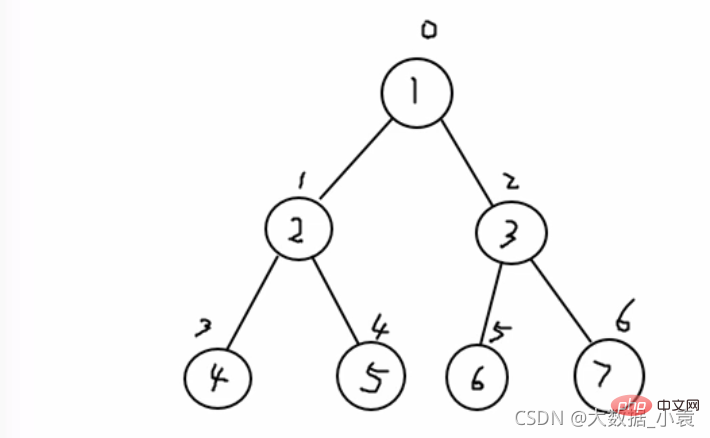
概述:顺序存储使用数组的形式实现;由于非完全二叉树会导致数组中出现空缺,有的位置不能填上数字,所以顺序存储二叉树通常情况下只考虑完全二叉树
原理: 顺序存储在数组中是按照第一层第二层一次往下存储的,遍历方式也有先序遍历、中序遍历、后续遍历
性质:
- 第n个元素的左子节点是:2*n+1;
- 第n个元素的右子节点是:2*n+2;
- 第n个元素的父节点是:(n-1)/2
代码实现:
| 1 2 3 4 5 6 7 8 9 10 11 12 13 14 15 16 17 18 19 20 21 22 23 24 25 26 27 28 29 | public class ArrayBinaryTree {
int[] data;
public ArrayBinaryTree(int[] data) {
this.data = data;
}
//重载先序遍历方法,不用每次传参数了,保证每次从头开始
public void frontShow() {
frontShow(0);
}
//先序遍历
public void frontShow(int index) {
if (data == null || data.length == 0) {
return;
}
//先遍历当前节点的内容
System.out.print(data[index] + " ");
//处理左子树:2*index+1
if (2 * index + 1 < data.length) {
frontShow(2 * index + 1);
}
//处理右子树:2*index+2
if (2 * index + 2 < data.length) {
frontShow(2 * index + 2);
}
}}
|
| 1 2 3 4 5 6 7 | public class Demo {
public static void main(String[] args) {
int[] data = {1,2,3,4,5,6,7};
ArrayBinaryTree tree = new ArrayBinaryTree(data);
//先序遍历
tree.frontShow(); //1 2 4 5 3 6 7
}}
|
7.6 线索二叉树(Threaded BinaryTree)
为什么使用线索二叉树?
当用二叉链表作为二叉树的存储结构时,可以很方便的找到某个结点的左右孩子;但一般情况下,无法直接找到该结点在某种遍历序列中的前驱和后继结点
原理:n个结点的二叉链表中含有n+1(2n-(n-1)=n+1个空指针域。利用二叉链表中的空指针域,存放指向结点在某种遍历次序下的前驱和后继结点的指针。
例如:某个结点的左孩子为空,则将空的左孩子指针域改为指向其前驱;如果某个结点的右孩子为空,则将空的右孩子指针域改为指向其后继(这种附加的指针称为"线索")
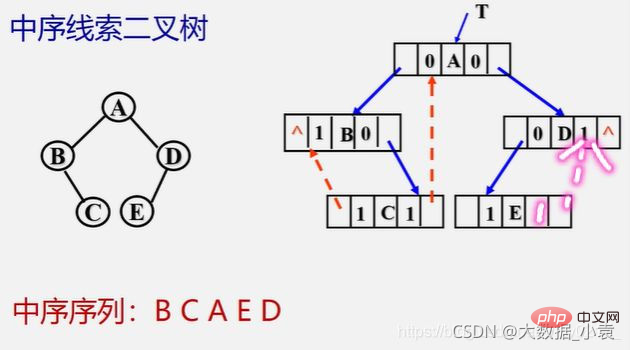
代码实现:
| 1 2 3 4 5 6 7 8 9 10 11 12 13 14 15 16 17 18 19 20 21 22 23 24 25 26 27 28 29 30 31 32 33 34 35 36 37 38 39 40 41 42 43 44 45 46 47 48 49 50 51 52 53 54 55 56 57 58 59 60 61 62 63 64 65 66 67 68 69 70 71 72 73 74 75 76 77 78 79 80 81 82 83 84 85 86 87 88 89 90 91 92 93 94 95 96 97 98 99 100 101 102 103 104 105 106 107 | public class ThreadedBinaryTree {
ThreadedNode root;
//用于临时存储前驱节点
ThreadedNode pre = null;
//设置根节点
public void setRoot(ThreadedNode root) {
this.root = root;
}
//中序线索化二叉树
public void threadNodes() {
threadNodes(root);
}
public void threadNodes(ThreadedNode node) {
//当前节点如果为null,直接返回
if (node == null) {
return;
}
//处理左子树
threadNodes(node.leftNode);
//处理前驱节点
if (node.leftNode == null) {
//让当前节点的左指针指向前驱节点
node.leftNode = pre;
//改变当前节点左指针类型
node.leftType = 1;
}
//处理前驱的右指针,如果前驱节点的右指针是null(没有右子树)
if (pre != null && pre.rightNode == null) {
//让前驱节点的右指针指向当前节点
pre.rightNode = node;
//改变前驱节点的右指针类型
pre.rightType = 1;
}
//每处理一个节点,当前节点是下一个节点的前驱节点
pre = node;
//处理右子树
threadNodes(node.rightNode);
}
//遍历线索二叉树
public void threadIterate() {
//用于临时存储当前遍历节点
ThreadedNode node = root;
while (node != null) {
//循环找到最开始的节点
while (node.leftType == 0) {
node = node.leftNode;
}
//打印当前节点的值
System.out.print(node.value + " ");
//如果当前节点的右指针指向的是后继节点,可能后继节点还有后继节点
while (node.rightType == 1) {
node = node.rightNode;
System.out.print(node.value + " ");
}
//替换遍历的节点
node = node.rightNode;
}
}
//获取根节点
public ThreadedNode getRoot() {
return root;
}
//先序遍历
public void frontShow() {
if (root != null) {
root.frontShow();
}
}
//中序遍历
public void middleShow() {
if (root != null) {
root.middleShow();
}
}
//后序遍历
public void afterShow() {
if (root != null) {
root.afterShow();
}
}
//先序查找
public ThreadedNode frontSearch(int i) {
return root.frontSearch(i);
}
//删除一个子树
public void delete(int i) {
if (root.value == i) {
root = null;
} else {
root.delete(i);
}
}}
|
| 1 2 3 4 5 6 7 8 9 10 11 12 13 14 15 16 17 18 19 20 21 22 23 24 25 26 27 28 29 30 31 32 33 34 35 36 37 38 39 40 41 42 43 44 45 46 47 48 49 50 51 52 53 54 55 56 57 58 59 60 61 62 63 64 65 66 67 68 69 70 71 72 73 74 75 76 77 78 79 80 81 82 83 84 85 86 87 88 89 90 91 92 93 94 95 96 97 98 99 100 101 102 103 104 105 106 107 108 109 110 111 112 113 114 115 116 117 | public class ThreadedNode {
//节点的权
int value;
//左儿子
ThreadedNode leftNode;
//右儿子
ThreadedNode rightNode;
//标识指针类型,1表示指向上一个节点,0
int leftType;
int rightType;
public ThreadedNode(int value) {
this.value = value;
}
//设置左儿子
public void setLeftNode(ThreadedNode leftNode) {
this.leftNode = leftNode;
}
//设置右儿子
public void setRightNode(ThreadedNode rightNode) {
this.rightNode = rightNode;
}
//先序遍历
public void frontShow() {
//先遍历当前节点的值
System.out.print(value + " ");
//左节点
if (leftNode != null) {
leftNode.frontShow(); //递归思想
}
//右节点
if (rightNode != null) {
rightNode.frontShow();
}
}
//中序遍历
public void middleShow() {
//左节点
if (leftNode != null) {
leftNode.middleShow(); //递归思想
}
//先遍历当前节点的值
System.out.print(value + " ");
//右节点
if (rightNode != null) {
rightNode.middleShow();
}
}
//后续遍历
public void afterShow() {
//左节点
if (leftNode != null) {
leftNode.afterShow(); //递归思想
}
//右节点
if (rightNode != null) {
rightNode.afterShow();
}
//先遍历当前节点的值
System.out.print(value + " ");
}
//先序查找
public ThreadedNode frontSearch(int i) {
ThreadedNode target = null;
//对比当前节点的值
if (this.value == i) {
return this;
//当前节点不是要查找的节点
} else {
//查找左儿子
if (leftNode != null) {
//查找的话t赋值给target,查不到target还是null
target = leftNode.frontSearch(i);
}
//如果target不为空,说明在左儿子中已经找到
if (target != null) {
return target;
}
//如果左儿子没有查到,再查找右儿子
if (rightNode != null) {
target = rightNode.frontSearch(i);
}
}
return target;
}
//删除一个子树
public void delete(int i) {
ThreadedNode parent = this;
//判断左儿子
if (parent.leftNode != null && parent.leftNode.value == i) {
parent.leftNode = null;
return;
}
//判断右儿子
if (parent.rightNode != null && parent.rightNode.value == i) {
parent.rightNode = null;
return;
}
//如果都不是,递归检查并删除左儿子
parent = leftNode;
if (parent != null) {
parent.delete(i);
}
//递归检查并删除右儿子
parent = rightNode;
if (parent != null) {
parent.delete(i);
}
}}
|
| 1 2 3 4 5 6 7 8 9 10 11 12 13 14 15 16 17 18 19 20 21 22 23 24 25 26 27 28 29 | public class Demo {
public static void main(String[] args) {
//创建一棵树
ThreadedBinaryTree binaryTree = new ThreadedBinaryTree();
//创建一个根节点
ThreadedNode root = new ThreadedNode(1);
//把根节点赋给树
binaryTree.setRoot(root);
//创建左,右节点
ThreadedNode rootLeft = new ThreadedNode(2);
ThreadedNode rootRight = new ThreadedNode(3);
//把新建的节点设置为根节点的子节点
root.setLeftNode(rootLeft);
root.setRightNode(rootRight);
//为第二层的左节点创建两个子节点
rootLeft.setLeftNode(new ThreadedNode(4));
ThreadedNode fiveNode = new ThreadedNode(5);
rootLeft.setRightNode(fiveNode);
//为第二层的右节点创建两个子节点
rootRight.setLeftNode(new ThreadedNode(6));
rootRight.setRightNode(new ThreadedNode(7));
//中序遍历
binaryTree.middleShow(); //4 2 5 1 6 3 7
System.out.println();
//中序线索化二叉树
binaryTree.threadNodes();// //获取5的后继节点// ThreadedNode afterFive = fiveNode.rightNode;// System.out.println(afterFive.value); //1
binaryTree.threadIterate(); //4 2 5 1 6 3 7
}}
|
7.7 二叉排序树(Binary Sort Tree)
无序序列:

二叉排序树图解:
概述:二叉排序树(Binary Sort Tree)也叫二叉查找树或者是一颗空树,对于二叉树中的任何一个非叶子节点,要求左子节点比当前节点值小,右子节点比当前节点值大
特点:
- 查找性能与插入删除性能都适中还不错
- 中序遍历的结果刚好是从大到小
创建二叉排序树原理:其实就是不断地插入节点,然后进行比较。
删除节点
- 删除叶子节点,只需要找到父节点,将父节点与他的连接断开即可
- 删除有一个子节点的就需要将他的子节点换到他现在的位置
- 删除有两个子节点的节点,需要使用他的前驱节点或者后继节点进行替换,就是左子树最右下方的数(最大的那个)或右子树最左边的树(最小的数);即离节点值最接近的值;(还要注解要去判断这个值有没有右节点,有就要将右节点移上来)
代码实现:
| 1 2 3 4 5 6 7 8 9 10 11 12 13 14 15 16 17 18 19 20 21 22 23 24 25 26 27 28 29 30 31 32 33 34 35 36 37 38 39 40 41 42 43 44 45 46 47 48 49 50 51 52 53 54 55 56 57 58 59 60 61 62 63 64 65 66 67 68 69 70 71 72 73 74 75 76 77 78 79 80 81 82 83 84 85 86 87 88 89 90 91 92 93 94 95 96 97 98 99 100 101 102 103 104 105 106 107 | public class BinarySortTree {
Node root;
//添加节点
public void add(Node node) {
//如果是一颗空树
if (root == null) {
root = node;
} else {
root.add(node);
}
}
//中序遍历
public void middleShow() {
if (root != null) {
root.middleShow(root);
}
}
//查找节点
public Node search(int value) {
if (root == null) {
return null;
}
return root.search(value);
}
//查找父节点
public Node searchParent(int value) {
if (root == null) {
return null;
}
return root.searchParent(value);
}
//删除节点
public void delete(int value) {
if (root == null) {
return;
} else {
//找到这个节点
Node target = search(value);
//如果没有这个节点
if (target == null) {
return;
}
//找到他的父节点
Node parent = searchParent(value);
//要删除的节点是叶子节点
if (target.left == null && target.left == null) {
//要删除的节点是父节点的左子节点
if (parent.left.value == value) {
parent.left = null;
}
//要删除的节点是父节点的右子节点
else {
parent.right = null;
}
}
//要删除的节点有两个子节点的情况
else if (target.left != null && target.right != null) {
//删除右子树中值最小的节点,并且获取到值
int min = deletMin(target.right);
//替换目标节点中的值
target.value = min;
}
//要删除的节点有一个左子节点或右子节点
else {
//有左子节点
if (target.left != null) {
//要删除的节点是父节点的左子节点
if (parent.left.value == value) {
parent.left = target.left;
}
//要删除的节点是父节点的右子节点
else {
parent.right = target.left;
}
}
//有右子节点
else {
//要删除的节点是父节点的左子节点
if (parent.left.value == value) {
parent.left = target.right;
}
//要删除的节点是父节点的右子节点
else {
parent.right = target.right;
}
}
}
}
}
//删除一棵树中最小的节点
private int deletMin(Node node) {
Node target = node;
//递归向左找最小值
while (target.left != null) {
target = target.left;
}
//删除最小的节点
delete(target.value);
return target.value;
}}
|
| 1 2 3 4 5 6 7 8 9 10 11 12 13 14 15 16 17 18 19 20 21 22 23 24 25 26 27 28 29 30 31 32 33 34 35 36 37 38 39 40 41 42 43 44 45 46 47 48 49 50 51 52 53 54 55 56 57 58 59 60 61 62 63 64 65 66 67 68 69 70 71 72 73 74 75 76 77 78 | public class Node {
int value;
Node left;
Node right;
public Node(int value) {
this.value = value;
}
//向子树中添加节点
public void add(Node node) {
if (node == null) {
return;
}
/*判断传入的节点的值比当前紫薯的根节点的值大还是小*/
//添加的节点比当前节点更小(传给左节点)
if (node.value < this.value) {
//如果左节点为空
if (this.left == null) {
this.left = node;
}
//如果不为空
else {
this.left.add(node);
}
}
//添加的节点比当前节点更大(传给右节点)
else {
if (this.right == null) {
this.right = node;
} else {
this.right.add(node);
}
}
}
//中序遍历二叉排序树,结果刚好是从小到大
public void middleShow(Node node) {
if (node == null) {
return;
}
middleShow(node.left);
System.out.print(node.value + " ");
middleShow(node.right);
}
//查找节点
public Node search(int value) {
if (this.value == value) {
return this;
} else if (value < this.value) {
if (left == null) {
return null;
}
return left.search(value);
} else {
if (right == null) {
return null;
}
return right.search(value);
}
}
//查找父节点
public Node searchParent(int value) {
if ((this.left != null && this.left.value == value) || (this.right != null && this.right.value == value)) {
return this;
} else {
if (this.value > value && this.left != null) {
return this.left.searchParent(value);
} else if (this.value < value && this.right != null) {
return this.right.searchParent(value);
}
return null;
}
}}
|
| 1 2 3 4 5 6 7 8 9 10 11 12 13 14 15 16 17 18 19 20 21 22 23 24 25 26 27 28 29 30 31 32 33 34 35 | public class Demo {
public static void main(String[] args) {
int[] arr = {8, 3, 10, 1, 6, 14, 4, 7, 13};
//创建一颗二叉排序树
BinarySortTree bst = new BinarySortTree();
//循环添加/* for(int i=0;i< arr.length;i++) {
bst.add(new Node(arr[i]));
}*/
for (int i : arr) {
bst.add(new Node(i));
}
//中序遍历
bst.middleShow(); //1 3 4 6 7 8 10 13 14
System.out.println();
//查找节点
Node node = bst.search(10);
System.out.println(node.value);//10
Node node2 = bst.search(20);
System.out.println(node2); //null
//查找父节点
Node node3 = bst.searchParent(1);
Node node4 = bst.searchParent(14);
System.out.println(node3.value); //3
System.out.println(node4.value); //10
//删除叶子节点// bst.delete(13);// bst.middleShow(); //1 3 4 6 7 8 10 14// System.out.println();// //删除只有一个子节点的节点// bst.delete(10);// bst.middleShow(); //1 3 4 6 7 8 ;10和14都没了
//删除有两个子节点的节点
bst.delete(3);
bst.middleShow(); //1 4 6 7 8 10 13 14
}}
|
7.8 平衡二叉树( Balanced Binary Tree)
为什么使用平衡二叉树?
平衡二叉树(Balanced Binary Tree)又被称为AVL树,且具有以下性质:它是一棵空树或它的左右两个子树的高度差的绝对值不超过1,并且左右两个子树都是一棵平衡二叉树。这个方案很好的解决了二叉查找树退化成链表的问题,把插入,查找,删除的时间复杂度最好情况和最坏情况都维持在O(logN)。但是频繁旋转会使插入和删除牺牲掉O(logN)左右的时间,不过相对二叉查找树来说,时间上稳定了很多。
二叉排序树插入 {1,2,3,4,5,6} 这种数据结果如下图所示:
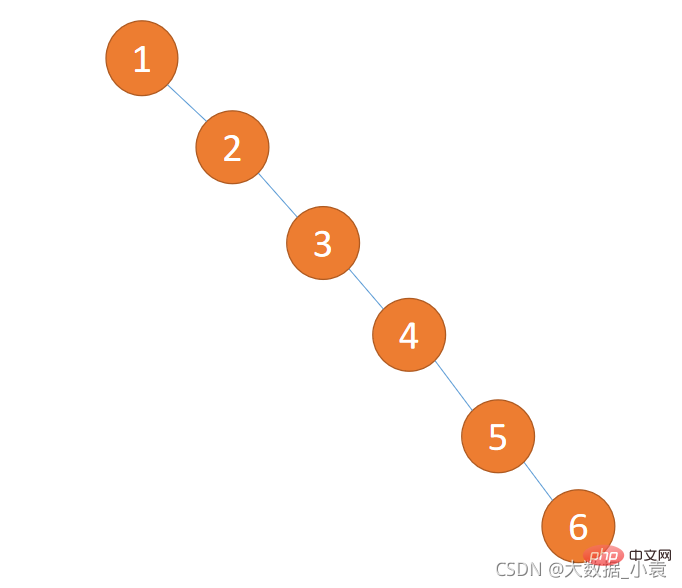
平衡二叉树插入 {1,2,3,4,5,6} 这种数据结果如下图所示:
如何判断平衡二叉树?
- 1、是二叉排序树
- 2、任何一个节点的左子树或者右子树都是平衡二叉树(左右高度差小于等于 1)
(1)下图不是平衡二叉树,因为它不是二叉排序树违反第 1 条件
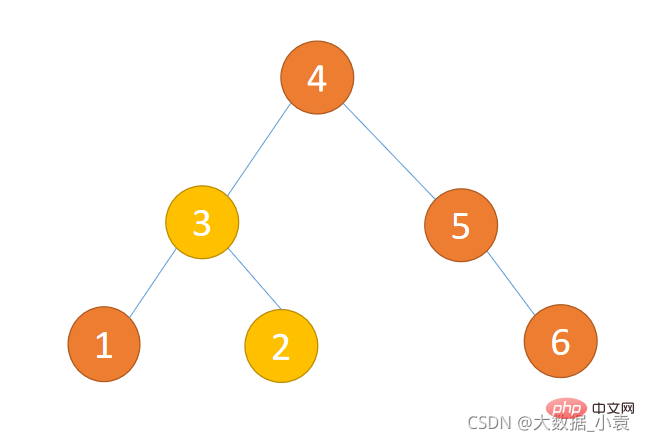
(2)下图不是平衡二叉树,因为有节点子树高度差大于 1 违法第 2 条件(5的左子树为0,右子树为2)
(3)下图是平衡二叉树,因为符合 1、2 条件

相关概念
平衡因子 BF
- 定义:左子树和右子树高度差
- 计算:
左子树高度 - 右子树高度的值 - 别名:简称 BF(Balance Factor)
- 一般来说 BF 的绝对值大于 1,,平衡树二叉树就失衡,需要旋转纠正
最小不平衡子树
旋转方式
2 种旋转方式:
左旋 :
- 旧根节点为新根节点的左子树
- 新根节点的左子树(如果存在)为旧根节点的右子树
右旋:
- 旧根节点为新根节点的右子树
- 新根节点的右子树(如果存在)为旧根节点的左子树
4 种旋转纠正类型:
- 左左型:插入左孩子的左子树,右旋
- 右右型:插入右孩子的右子树,左旋
- 左右型:插入左孩子的右子树,先左旋,再右旋
- 右左型:插入右孩子的左子树,先右旋,再左旋
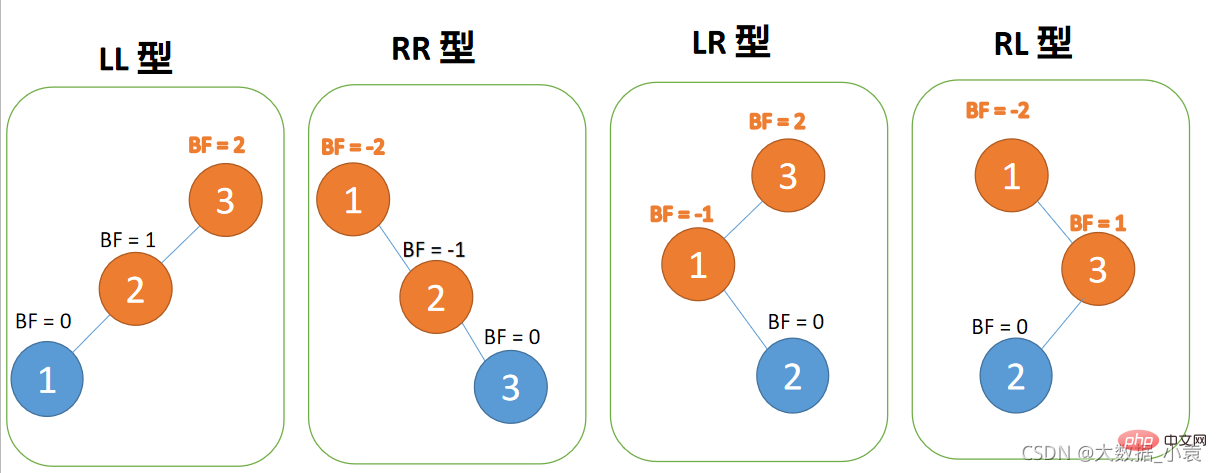
左左型:
第三个节点(1)插入的时候,BF(3) = 2,BF(2) = 1,右旋,根节点顺时针旋转
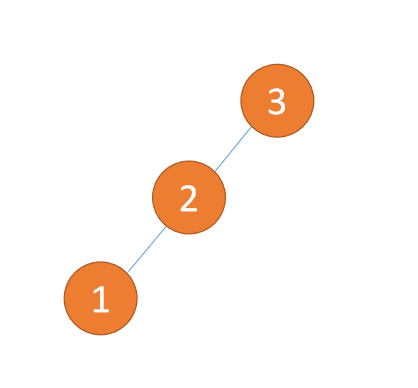
右右型:
第三个节点(3)插入的时候,BF(1)=-2 BF(2)=-1,RR 型失衡,左旋,根节点逆时针旋转
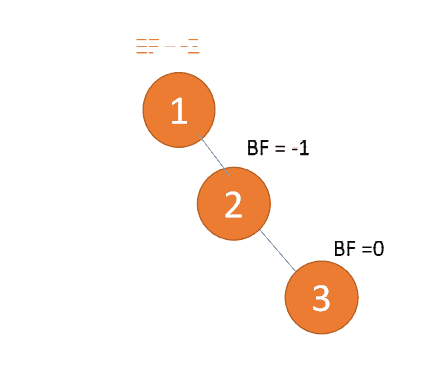
左右型:
第三个节点(3)插入的 时候,BF(3)=2 BF(1)=-1 LR 型失衡,先 左旋 再 右旋
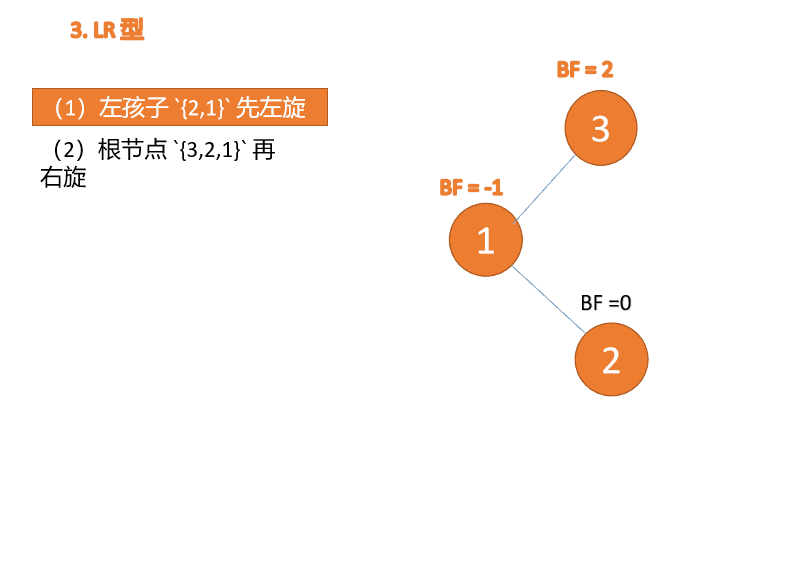
右左型:
第三个节点(1)插入的 时候,BF(1)=-2 BF(3)=1 RL 型失衡,先 右旋 再 左旋
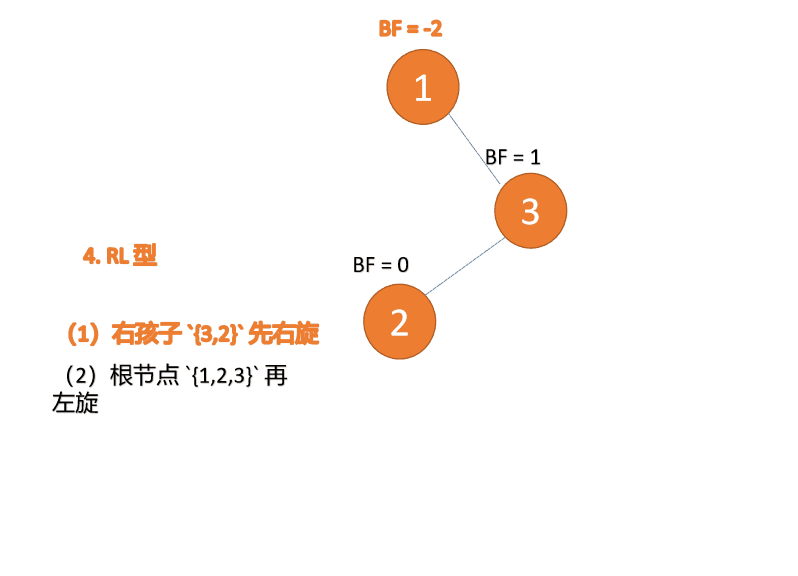
实例
(1)、依次插入 3、2、1 插入第三个点 1 的时候 BF(3)=2 BF(2)=1,LL 型失衡,对最小不平衡树 {3,2,1}进行 右旋
- 旧根节点(节点 3)为新根节点(节点 2)的右子树
- 新根节点(节点 2)的右子树(这里没有右子树)为旧根节点的左子树
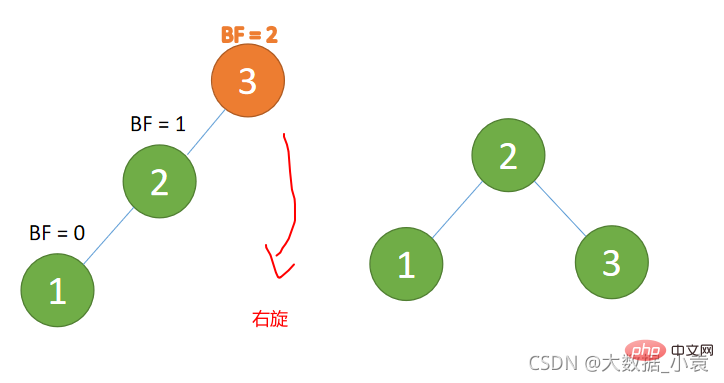
(2)依次插入 4 ,5 插入 5 点的时候 BF(3) = -2 BF(4)=-1,RR 型失衡,对最小不平衡树 {3,4,5} 进行左旋
- 旧根节点(节点 3)为新根节点(节点 4)的左子树
- 新根节点(节点 4)的左子树(这里没有左子树)为旧根节点的右子树

(3)插入 4 ,5 插入 5 点的时候 BF(2)=-2 BF(4)=-1 ,RR 型失衡 对最小不平衡树{1,2,4}进行左旋
- 旧根节点(节点 2)为新根节点(节点 4)的左子树
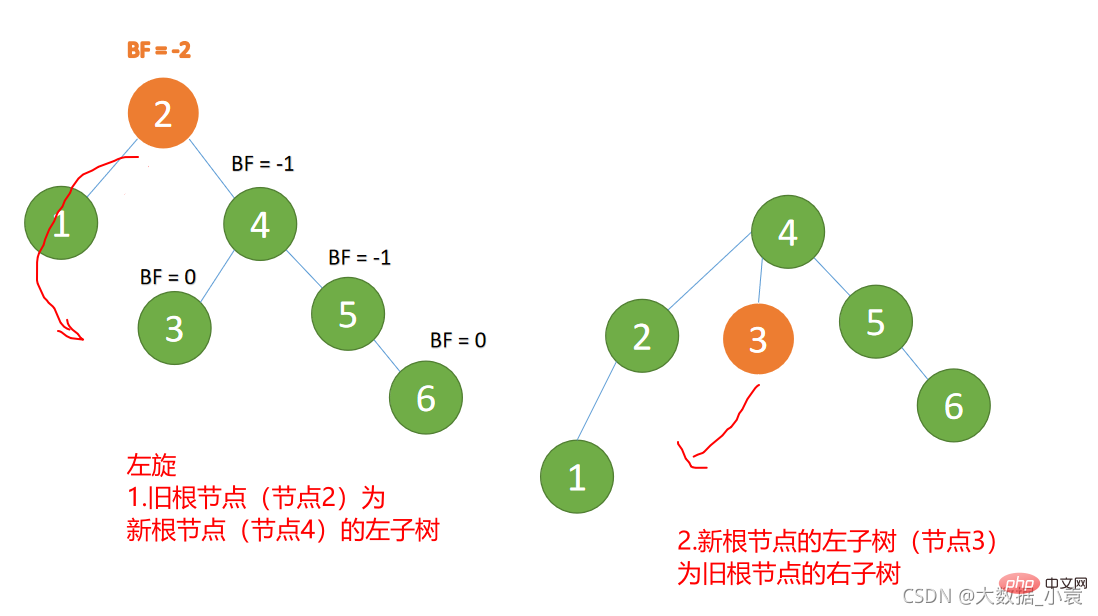
- 新根节点(节点 4)的 左子树(节点 3)为旧根节点的右子树

(4)插入 7 节点的时候 BF(5)=-2, BF(6)=-1 ,RR 型失衡,对最小不平衡树 进行左旋
- 旧根节点(节点 5)为新根节点(节点 6)的左子树
- 新根节点的左子树(这里没有)为旧根节点的右子树
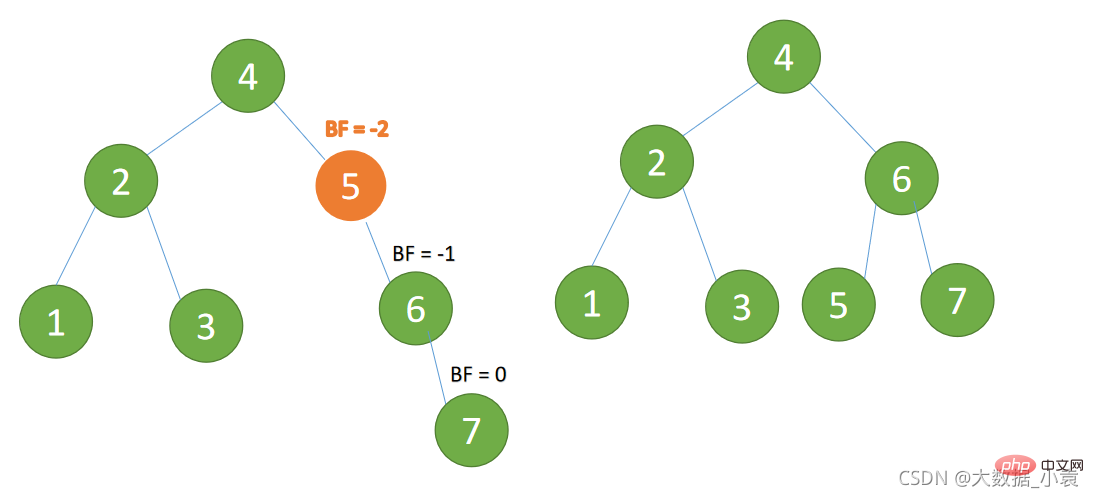
(5)依次插入 10 ,9 。插入 9 点的时候 BF(10) = 1,BF(7) = -2,RL 型失衡,对先右旋再左旋,右子树先右旋
- 旧根节点(节点 10)为新根节点(节点 9)的右子树
- 新根节点(节点 9)的右子树(这里没有右子树)为旧根节点的左子树
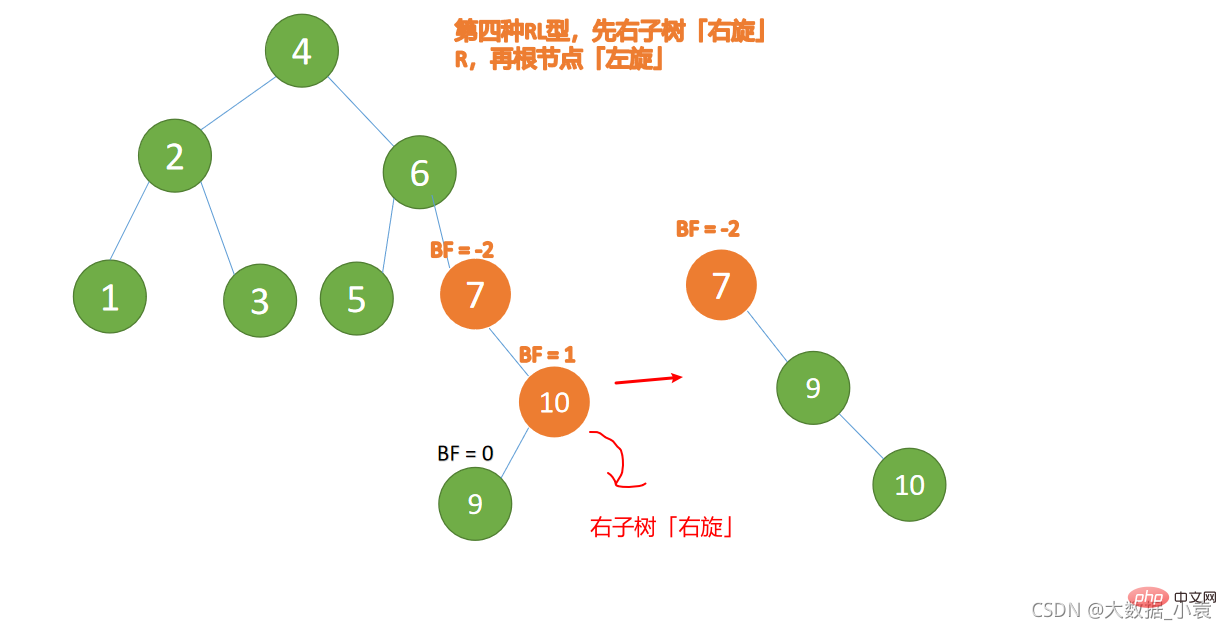
最小不平衡子树再左旋: - 旧根节点(节点 7)为新根节点(节点 9)的左子树
- 新根节点(节点 9)的左子树(这里没有左子树)为旧根节点的右子树
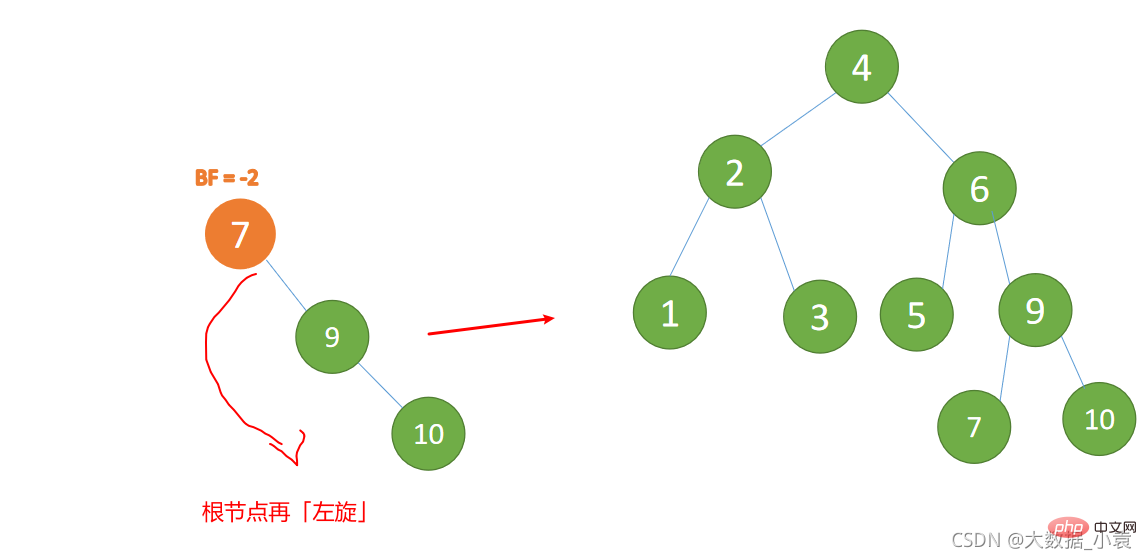
代码实现
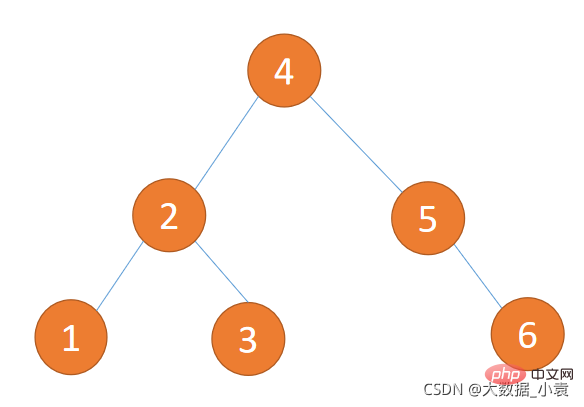
| 1 2 3 4 5 6 7 8 9 10 11 12 13 14 15 16 17 18 19 20 21 22 23 24 25 26 27 28 29 30 31 32 33 34 35 36 37 38 39 40 41 42 43 44 45 46 47 48 49 50 51 52 53 54 55 56 57 58 59 60 61 62 63 64 65 66 67 68 69 70 71 72 73 74 75 76 77 78 79 80 81 82 83 84 85 86 87 88 89 90 91 92 93 94 95 96 97 98 99 100 101 102 103 104 105 106 107 108 109 110 111 112 113 114 115 116 117 118 119 120 121 122 123 124 125 126 127 128 129 130 131 132 133 134 135 136 137 138 139 140 141 142 143 144 145 146 147 148 149 150 151 152 153 154 155 156 157 158 159 | public class Node {
int value;
Node left;
Node right;
public Node(int value) {
this.value = value;
}
//获取当前节点高度
public int height() {
return Math.max(left == null ? 0 : left.height(), right == null ? 0 : right.height()) + 1;
}
//获取左子树高度
public int leftHeight() {
if (left == null) {
return 0;
}
return left.height();
}
//获取右子树高度
public int rightHeight() {
if (right == null) {
return 0;
}
return right.height();
}
//向子树中添加节点
public void add(Node node) {
if (node == null) {
return;
}
/*判断传入的节点的值比当前紫薯的根节点的值大还是小*/
//添加的节点比当前节点更小(传给左节点)
if (node.value < this.value) {
//如果左节点为空
if (this.left == null) {
this.left = node;
}
//如果不为空
else {
this.left.add(node);
}
}
//添加的节点比当前节点更大(传给右节点)
else {
if (this.right == null) {
this.right = node;
} else {
this.right.add(node);
}
}
//查询是否平衡
//右旋转
if (leftHeight() - rightHeight() >= 2) {
//双旋转,当左子树左边高度小于左子树右边高度时
if (left != null && left.leftHeight() < left.rightHeight()) {
//左子树先进行左旋转
left.leftRotate();
//整体进行右旋转
rightRotate();
}
//单旋转
else {
rightRotate();
}
}
//左旋转
if (leftHeight() - rightHeight() <= -2) {
//双旋转
if (right != null && right.rightHeight() < right.leftHeight()) {
right.rightRotate();
leftRotate();
}
//单旋转
else {
leftRotate();
}
}
}
//右旋转
private void rightRotate() {
//创建一个新的节点,值等于当前节点的值
Node newRight = new Node(value);
//把新节点的右子树设置为当前节点的右子树
newRight.right = right;
//把新节点的左子树设置为当前节点的左子树的右子树
newRight.left = left.right;
//把当前节点的值换位左子节点的值
value = left.value;
//把当前节点的左子树设置为左子树的左子树
left = left.left;
//把当前节点设置为新节点
right = newRight;
}
//左旋转
private void leftRotate() {
//创建一个新的节点,值等于当前节点的值
Node newLeft = new Node(value);
//把新节点的左子树设置为当前节点的左子树
newLeft.left = left;
//把新节点的右子树设置为当前节点的右子树的左子树
newLeft.right = right.left;
//把当前节点的值换位右子节点的值
value = right.value;
//把当前节点的右子树设置为右子树的右子树
right = right.right;
//把当前节点设置为新节点
left = newLeft;
}
//中序遍历二叉排序树,结果刚好是从小到大
public void middleShow(Node node) {
if (node == null) {
return;
}
middleShow(node.left);
System.out.print(node.value + " ");
middleShow(node.right);
}
//查找节点
public Node search(int value) {
if (this.value == value) {
return this;
} else if (value < this.value) {
if (left == null) {
return null;
}
return left.search(value);
} else {
if (right == null) {
return null;
}
return right.search(value);
}
}
//查找父节点
public Node searchParent(int value) {
if ((this.left != null && this.left.value == value) || (this.right != null && this.right.value == value)) {
return this;
} else {
if (this.value > value && this.left != null) {
return this.left.searchParent(value);
} else if (this.value < value && this.right != null) {
return this.right.searchParent(value);
}
return null;
}
}}
|
| 1 2 3 4 5 6 7 8 9 10 11 12 13 14 15 16 | public class Demo {
public static void main(String[] args) {
int[] arr = {1,2,3,4,5,6};
//创建一颗二叉排序树
BinarySortTree bst = new BinarySortTree();
//循环添加
for (int i : arr) {
bst.add(new Node(i));
}
//查看高度
System.out.println(bst.root.height()); //3
//查看节点值
System.out.println(bst.root.value); //根节点为4
System.out.println(bst.root.left.value); //左子节点为2
System.out.println(bst.root.right.value); //右子节点为5
}}
|















































 6843
6843

 被折叠的 条评论
为什么被折叠?
被折叠的 条评论
为什么被折叠?








